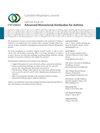“无创通气断奶治疗慢性阻塞性肺病急性高capnic呼吸衰竭:一项真实的观察研究”
IF 2.1
4区 医学
Q3 RESPIRATORY SYSTEM
引用次数: 1
摘要
我们饶有兴趣地阅读了P.Faverio等人发表在本杂志上的文章[1]。我们感谢作者能够建立一个充分的无创通气(NIV)断奶策略,包括中断通气*这篇文章也正确地强调了在这方面缺乏共识和研究。尽管这项研究采用了回顾性设计,但经过检验的假设和提供的证据是令人信服的。然而,我们认为一些有趣的实际方面值得一提。虽然作者已经很好地测试了NIV中断的方法,但断奶的每个阶段的天数,仅在下午和晚上或夜间NIV,由医生自行决定*is是一个令人兴奋的方面,也是一个令人困惑的方面,因为最终,标准可能会受到广泛的个体变异性的影响,这可能导致无法推断结果。慢性家庭NIV组中有相当多(39%)的患者无法通过新方法断奶,并继续在家庭NIV环境中。由于这类患者没有明确的标准,因此有必要了解这些患者的情况,这些患者是否最终稳定下来,如果是,“如何”。这些方面将有助于读者在未来更好地应用或排除这一亚组患者中新的基于中断的断奶。作者认为严重大疱性肺气肿引起的肺炎是不断奶的危险因素。虽然我们同意这类患者容易不断奶,但它更多地与所选择的吸气正压和呼气末正压水平有关[2]。然而,作者使用的正压并没有那么高,因此这项研究并不清楚这种联系。所有这些方面都让我们相信,如果考虑到这些患者,结果可能会有所不同。我们再次感谢作者通过新方法观察到断奶后住院期间AHRF没有复发*是有趣的,并引发了人们的猜测,这是否可以被视为NIV的一个保护方面。一项前瞻性随机研究将为我们提供更多关于这些方面的证据,特别是哪一组患者将从这项新技术中受益。本文章由计算机程序翻译,如有差异,请以英文原文为准。
Comment on “Noninvasive Ventilation Weaning in Acute Hypercapnic Respiratory Failure due to COPD Exacerbation: A Real-Life Observational Study”
We have read with great interest the article by P. Faverio et al. published in this journal [1]. We thank the authors for being able to establish an adequate strategy of weaning from noninvasive ventilation (NIV) incorporating interruption of ventilation. *e article also rightly highlights the lack of consensus and studies in this regard. Although the study has a retrospective design, the hypothesis tested and evidence provided are compelling. Yet, we consider that some interesting practical aspects are worth mentioning. While the authors have tested the methodology of NIV interruption well, the number of days at each stage of weaning, NIV during afternoon and night or nocturnal NIV only, was at physician discretion. *is is an exciting aspect and confusing as well because, eventually, the criteria may be influenced by wide individual variability, which may make it impossible to extrapolate the results. Good numbers (39%) of the patients in the chronic domiciliary NIV group were not able to be weaned by the new method and continued to be in the domiciliary NIV settings. As there are no clear criteria for such patients, it will be worth knowing the settings, whether these patients were finally stabilized, and if yes, “how.” *ese aspects will help readers in better application or exclusion of the new interruption-based weaning in this subgroup of patients in the future. Pneumothorax due to severe bullous emphysema is considered by the authors as a risk factor for not weaning. While we agree that such patients are prone to not weaning, pneumothorax it is more related to the selected positive inspiratory and end-expiratory pressure levels selected [2]. However, the positive pressure used by the authors was not so high, so this association was not much clear from this study. All these aspects lead us to believe that if these patients were taken into account, the results might have been different. We again thank the authors for another interesting observation of no recurrence of AHRF during hospitalization after weaning by the new method. *is is interesting and raises speculation whether this can be considered as a protective aspect of the NIV. A prospective randomized study will give us more evidence on these aspects, especially which subgroup of patients will be benefited by this new technique.
求助全文
通过发布文献求助,成功后即可免费获取论文全文。
去求助
来源期刊

Canadian respiratory journal
医学-呼吸系统
CiteScore
4.20
自引率
0.00%
发文量
61
审稿时长
6-12 weeks
期刊介绍:
Canadian Respiratory Journal is a peer-reviewed, Open Access journal that aims to provide a multidisciplinary forum for research in all areas of respiratory medicine. The journal publishes original research articles, review articles, and clinical studies related to asthma, allergy, COPD, non-invasive ventilation, therapeutic intervention, lung cancer, airway and lung infections, as well as any other respiratory diseases.
 求助内容:
求助内容: 应助结果提醒方式:
应助结果提醒方式:


